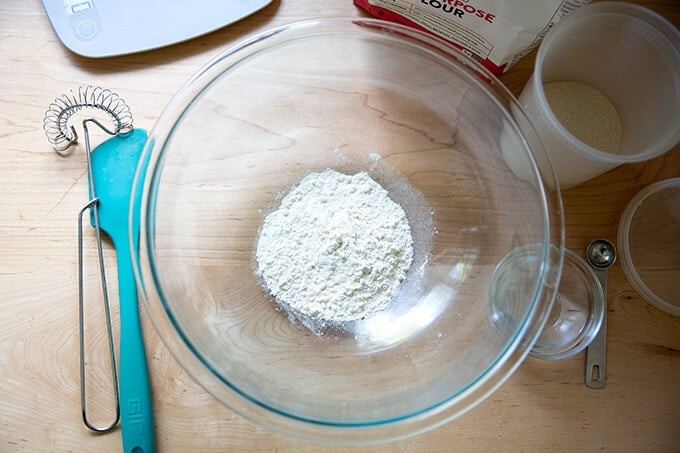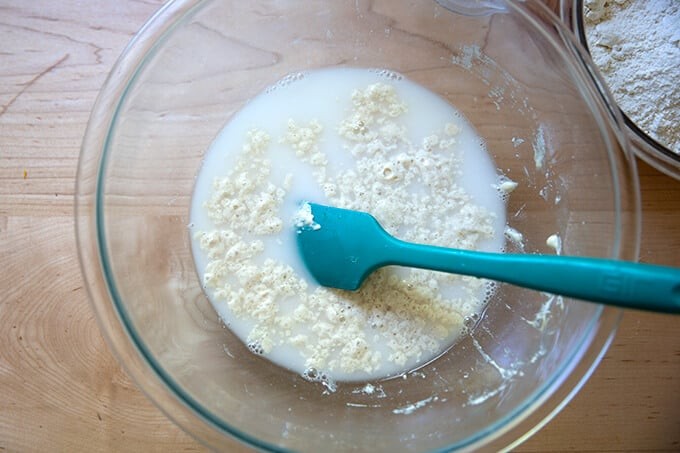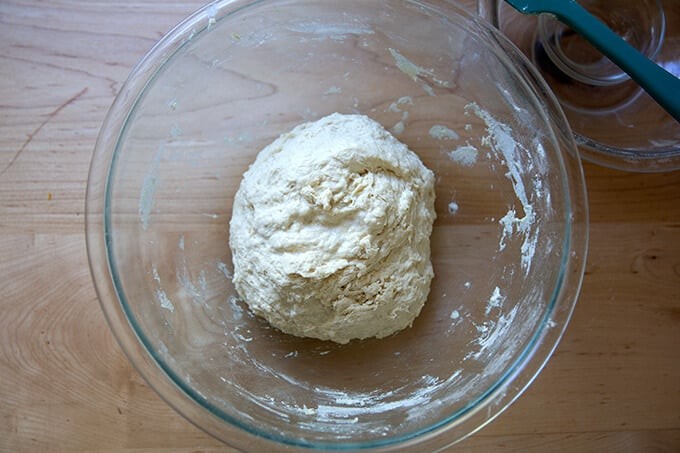Ciabatta bread, that delightful Italian loaf, is known for its distinct flavor and texture. Wondering what makes it so special? At WHAT.EDU.VN, we’re here to provide you with a comprehensive exploration of What Is Ciabatta Bread, from its origins to its uses, offering a complete understanding of this classic baked good. Discover ciabatta’s taste profile, appearance, and airy crumb structure.
1. Exploring the Origins of Ciabatta Bread
Ciabatta, meaning “slipper” in Italian, is a relatively modern bread that was first created in 1982 by Arnaldo Cavallari, a baker in Adria, Veneto, Italy. Cavallari sought to create a uniquely Italian bread to compete with the increasingly popular French baguette. His goal was to develop a bread that captured the essence of Italian baking traditions while offering a distinct texture and flavor profile.
1.1. The Birth of a Unique Bread
Cavallari experimented with different types of flour, hydration levels, and fermentation techniques to achieve the perfect ciabatta. He aimed for a bread with a rustic appearance, an open crumb structure, and a slightly tangy flavor. The result was a bread with a unique shape reminiscent of a slipper, hence the name “ciabatta.”
1.2. The Key to Ciabatta’s Success
Several factors contributed to the success of ciabatta:
- High Hydration: Ciabatta dough has a high water content, typically around 70-80%, which results in a moist and airy crumb.
- Strong Flour: The use of strong bread flour with high protein content helps to develop gluten, which is essential for the bread’s structure and chewiness.
- Prefermentation: Many ciabatta recipes use a biga or poolish, a preferment made with flour, water, and a small amount of yeast, to enhance the flavor and texture of the bread.
- Folding Technique: Instead of traditional kneading, ciabatta dough is often folded to develop gluten and incorporate air, contributing to its open crumb.
1.3. Ciabatta vs. Baguette: A Comparative Look
While both ciabatta and baguette are popular European breads, they have distinct differences:
| Feature | Ciabatta | Baguette |
|---|---|---|
| Origin | Italy | France |
| Shape | Flat, elongated, and slipper-shaped | Long, thin, and cylindrical |
| Crumb | Open, airy, and irregular | Dense and even |
| Crust | Rustic, flour-dusted, and chewy | Crisp and golden |
| Flavor | Mildly tangy, with a subtle sweetness | Mild and slightly nutty |
| Hydration | High (70-80%) | Medium (60-70%) |
| Common Uses | Sandwiches, paninis, dipping in olive oil, bruschetta | Sandwiches, toast, accompanying soups and stews |





2. Understanding the Characteristics of Ciabatta Bread
Ciabatta bread is defined by its unique combination of texture, appearance, and taste. These qualities make it a versatile choice for a wide range of culinary applications.
2.1. Defining the Texture of Ciabatta
The texture of ciabatta is one of its most distinguishing characteristics. It is known for its:
- Open Crumb: The large, irregular air pockets create a light and airy texture.
- Chewy Crust: The crust is slightly chewy, providing a satisfying contrast to the soft interior.
- Moist Interior: The high hydration level keeps the inside of the bread moist and tender.
2.2. Examining the Appearance of Ciabatta
Ciabatta’s appearance is rustic and artisanal, marked by:
- Elongated Shape: Its characteristic slipper shape is often flattened and irregular.
- Flour-Dusted Crust: The surface is typically dusted with flour, giving it a matte finish.
- Uneven Surface: The crust may have small bubbles and imperfections, adding to its charm.
2.3. Describing the Taste of Ciabatta
Ciabatta offers a subtle yet satisfying flavor profile:
- Mildly Tangy: A slight tanginess from the prefermentation process adds complexity.
- Subtle Sweetness: A hint of sweetness complements the savory notes.
- Versatile Flavor: The mild flavor makes it a great accompaniment to various ingredients.
3. The Essential Ingredients for Making Ciabatta
Creating authentic ciabatta bread requires specific ingredients that contribute to its unique texture and flavor.
3.1. Flour: The Foundation of Ciabatta
- Bread Flour: High-protein bread flour is essential for developing the gluten structure that gives ciabatta its chewiness and open crumb. It is recommended to use flour with a protein content of 12-14%.
3.2. Water: Achieving High Hydration
- Water: Ciabatta dough requires a high amount of water, typically 70-80% hydration, to create a moist and airy crumb. The water should be lukewarm to activate the yeast effectively.
3.3. Yeast: The Leavening Agent
- Yeast: Instant dry yeast or fresh yeast can be used to leaven the dough. Instant dry yeast is convenient and readily available, while fresh yeast may impart a slightly richer flavor.
3.4. Salt: Enhancing Flavor and Structure
- Salt: Salt not only enhances the flavor of the bread but also strengthens the gluten structure. It is important to use the correct amount of salt to achieve the desired texture and taste.
3.5. Optional Ingredients: Exploring Variations
- Olive Oil: Some recipes include a small amount of olive oil to add richness and moisture to the dough.
- Milk: Milk can be used to create a softer crumb and slightly sweeter flavor.
- Malt Extract: A small amount of malt extract can enhance the flavor and color of the crust.
4. Step-by-Step Guide to Making Ciabatta Bread
Making ciabatta bread at home can be a rewarding experience. Here is a detailed guide to help you create a perfect loaf.
4.1. Preparing the Poolish (Preferment)
-
Ingredients:
- 100g bread flour
- 100ml lukewarm water
- 1g instant dry yeast
-
Instructions:
- In a bowl, combine the flour and yeast.
- Add the lukewarm water and mix until a smooth batter forms.
- Cover the bowl and let it sit at room temperature for 12-16 hours, or until bubbly and slightly risen.
4.2. Mixing the Dough
-
Ingredients:
- All of the poolish
- 400g bread flour
- 300ml lukewarm water
- 10g salt
-
Instructions:
- In a large bowl, combine the poolish, flour, and water.
- Mix until a shaggy dough forms.
- Let the dough rest for 30 minutes (autolyse).
- Add the salt and mix until fully incorporated.
4.3. Folding the Dough
- Instructions:
- Wet your hands to prevent sticking.
- Gently stretch one side of the dough and fold it over the center.
- Rotate the bowl and repeat this process until you have folded the dough from all sides.
- Cover the bowl and let it rest for 30 minutes.
- Repeat this folding process 3-4 times over the next 1.5-2 hours.
4.4. Bulk Fermentation
- Instructions:
- After the final fold, cover the bowl and let the dough rise at room temperature for 2-3 hours, or until it has nearly doubled in size.
4.5. Shaping the Dough
- Instructions:
- Generously flour a work surface.
- Gently turn the dough out onto the floured surface.
- Using a bench scraper, divide the dough into two or three portions.
- Gently shape each portion into a rectangular or elongated shape without degassing it too much.
4.6. Proofing the Dough
- Instructions:
- Place the shaped loaves on a floured kitchen towel or parchment paper.
- Cover them loosely with plastic wrap and let them proof for 1-1.5 hours, or until slightly puffy.
4.7. Baking the Ciabatta
- Instructions:
- Preheat your oven to 450°F (232°C) with a baking stone or Dutch oven inside.
- Carefully transfer the loaves onto the hot baking stone or into the Dutch oven.
- If using a baking stone, add steam to the oven by pouring hot water into a preheated pan on the bottom rack.
- Bake for 20-25 minutes, or until the crust is golden brown and the internal temperature reaches 200-210°F (93-99°C).
- Let the ciabatta cool completely on a wire rack before slicing and serving.
5. Mastering the Art of Ciabatta Bread Baking: Tips and Tricks
Achieving the perfect ciabatta loaf requires attention to detail and a few key techniques.
5.1. Hydration is Key
Ciabatta is known for its high hydration, which is essential for creating the signature open crumb. Achieving the right balance can be tricky, but here are some tips:
- Measure Accurately: Use a kitchen scale to measure ingredients accurately, especially water.
- Adjust as Needed: Depending on your flour and environment, you may need to adjust the amount of water. If the dough is too wet and unmanageable, reduce the water slightly.
5.2. Gluten Development Techniques
Proper gluten development is crucial for the structure of ciabatta. Here are some techniques to help:
- Autolyse: Allowing the flour and water to sit together for 30 minutes before adding salt helps to hydrate the flour and develop gluten.
- Folding: Instead of kneading, use a folding technique to strengthen the gluten. This involves gently stretching and folding the dough over itself several times during the first few hours of fermentation.
5.3. Fermentation: Patience is a Virtue
Fermentation is a critical step in developing the flavor and texture of ciabatta.
- Long, Slow Rise: Ciabatta benefits from a long, slow rise. This allows the yeast to develop complex flavors and create a more open crumb.
- Temperature Control: Keep the dough at a consistent temperature during fermentation. Avoid drafts and extreme temperatures.
5.4. Shaping Without Deflating
Shaping ciabatta can be challenging because the dough is very wet and delicate.
- Gentle Handling: Handle the dough gently to avoid degassing it.
- Floured Surface: Use a generously floured surface to prevent sticking.
- Bench Scraper: A bench scraper can be helpful for dividing and shaping the dough.
5.5. Baking for the Perfect Crust
Achieving a crisp, golden crust is the final step in making perfect ciabatta.
- High Temperature: Bake ciabatta at a high temperature (450°F or 232°C) to create a crisp crust.
- Steam: Add steam to the oven during the first part of baking to promote a shiny, blistered crust.
- Baking Stone or Dutch Oven: Using a baking stone or Dutch oven helps to create even heat distribution and a crisp crust.
6. Common Problems and Solutions in Ciabatta Baking
Even with the best intentions, ciabatta baking can sometimes present challenges. Here are some common problems and their solutions:
6.1. Dough Too Sticky
- Problem: The dough is too wet and difficult to handle.
- Solution:
- Reduce the amount of water slightly in the next batch.
- Use a higher-protein flour.
- Work with well-floured hands and a floured surface.
6.2. Dense Crumb
- Problem: The crumb is dense and lacks the characteristic open structure.
- Solution:
- Ensure the poolish is active and bubbly before using it.
- Increase the fermentation time.
- Handle the dough gently during shaping to avoid degassing it.
- Make sure your oven is hot enough.
6.3. Flat Loaf
- Problem: The loaf spreads out and becomes flat during baking.
- Solution:
- Strengthen the gluten by folding the dough more frequently.
- Reduce the hydration slightly.
- Make sure the dough is properly proofed before baking.
6.4. Pale Crust
- Problem: The crust is pale and lacks color.
- Solution:
- Bake at a higher temperature.
- Add steam to the oven during the first part of baking.
- Brush the loaf with an egg wash or milk before baking.
6.5. Tough Crust
- Problem: The crust is too hard and difficult to chew.
- Solution:
- Reduce the baking time slightly.
- Add steam to the oven during the first part of baking.
- Let the loaf cool completely before slicing.
7. Serving Suggestions for Ciabatta Bread
Ciabatta’s versatile flavor and texture make it an excellent choice for a variety of dishes.
7.1. Sandwiches and Paninis
- Classic Sandwiches: Use ciabatta for classic sandwiches with cold cuts, cheeses, and vegetables.
- Grilled Paninis: Ciabatta’s sturdy texture makes it perfect for grilling as paninis with your favorite fillings.
7.2. Bruschetta and Crostini
- Toasted Bruschetta: Toast slices of ciabatta and top with fresh tomatoes, basil, and garlic for a simple bruschetta.
- Savory Crostini: Create savory crostini with various toppings like cheese spreads, tapenades, and roasted vegetables.
7.3. Dipping and Accompaniments
- Olive Oil Dip: Serve ciabatta with a bowl of high-quality olive oil for dipping.
- Soup and Stew Accompaniment: Ciabatta is an excellent accompaniment to soups, stews, and salads.
7.4. Bread Salads
- Panzanella: Use day-old ciabatta in a traditional Panzanella salad with tomatoes, cucumbers, and basil.
7.5. Creative Ideas
- Ciabatta Pizza: Top ciabatta with your favorite pizza ingredients and bake for a quick and easy pizza.
- Bread Pudding: Use ciabatta in a bread pudding for a delicious and comforting dessert.
8. Health Benefits of Ciabatta Bread
While ciabatta is a delicious treat, it also offers some nutritional benefits when consumed in moderation.
8.1. Source of Carbohydrates
- Energy: Ciabatta provides carbohydrates, which are the body’s primary source of energy.
8.2. Contains Fiber
- Digestive Health: Whole wheat ciabatta contains fiber, which aids in digestion and promotes gut health.
8.3. Nutrients
- Vitamins and Minerals: Ciabatta can provide essential vitamins and minerals, depending on the flour used.
8.4. Low in Fat
- Healthy Option: Ciabatta is relatively low in fat, making it a healthier option compared to some other types of bread.
8.5. Considerations
- Moderation: Like all breads, ciabatta should be consumed in moderation as part of a balanced diet.
- Ingredients: Be mindful of the ingredients used, as some commercial ciabatta may contain additives or preservatives.
9. Exploring Different Ciabatta Variations
While traditional ciabatta is delicious on its own, there are many variations to explore.
9.1. Whole Wheat Ciabatta
- Nutritious: Made with whole wheat flour, this variation is higher in fiber and nutrients.
9.2. Olive Ciabatta
- Flavorful: Incorporating olives into the dough adds a savory and briny flavor.
9.3. Rosemary Ciabatta
- Aromatic: Infused with fresh rosemary, this ciabatta has a fragrant and herbal aroma.
9.4. Cheese Ciabatta
- Cheesy Delight: Adding cheese, such as Parmesan or Asiago, creates a rich and flavorful bread.
9.5. Sun-Dried Tomato Ciabatta
- Tangy and Sweet: Incorporating sun-dried tomatoes adds a tangy and slightly sweet flavor.
10. Storing Ciabatta Bread for Freshness
Proper storage is essential for maintaining the freshness and quality of ciabatta.
10.1. Room Temperature
- Bread Box: Store ciabatta in a bread box or airtight container at room temperature for up to 2-3 days.
- Paper Bag: Wrap the bread in a paper bag to allow it to breathe while preventing it from drying out too quickly.
10.2. Freezing
- Slicing: Slice the ciabatta before freezing for easier thawing.
- Airtight Bag: Wrap the slices tightly in plastic wrap and place them in an airtight freezer bag.
- Freezing Time: Frozen ciabatta can last for up to 2-3 months.
10.3. Reheating
- Oven: Reheat frozen ciabatta in a preheated oven at 350°F (175°C) for 5-10 minutes.
- Toaster: Toast individual slices for a quick and easy snack.
10.4. Reviving Stale Ciabatta
- Water: Lightly sprinkle the stale ciabatta with water.
- Oven: Reheat it in a preheated oven at 350°F (175°C) for 5-10 minutes to restore its crust and texture.
11. The Global Popularity of Ciabatta Bread
From its humble beginnings in Italy, ciabatta has become a global favorite, enjoyed in various cuisines around the world.
11.1. European Influence
- Italy: Ciabatta remains a staple in Italian cuisine, used in sandwiches, bruschetta, and as an accompaniment to meals.
- France: Popular in French bakeries, often used for sandwiches and as a side to soups and salads.
- Spain: Commonly found in tapas bars, served with olive oil and other Spanish delicacies.
11.2. North American Adaptations
- United States: Ciabatta is widely available in supermarkets and bakeries, used for sandwiches, paninis, and as a table bread.
- Canada: A popular choice for sandwiches and often served in cafes and restaurants.
11.3. Other Regions
- Australia: Enjoyed as a sandwich bread and often served with antipasto platters.
- South America: Found in many bakeries, used for sandwiches and as a side to meals.
- Asia: Increasingly popular in cafes and restaurants, often adapted to local flavors and ingredients.
12. Ciabatta in Modern Culinary Trends
Ciabatta has found its place in modern culinary trends, with chefs and home cooks experimenting with new and innovative ways to use it.
12.1. Artisan Sandwiches
- Gourmet Fillings: Ciabatta is used as the base for artisan sandwiches with gourmet fillings like roasted vegetables, artisanal cheeses, and премиум meats.
- Creative Combinations: Chefs are creating unique flavor combinations that highlight the bread’s versatility.
12.2. Fusion Cuisine
- Global Flavors: Ciabatta is being used in fusion cuisine to create dishes that blend Italian traditions with global flavors.
- Innovative Dishes: Chefs are experimenting with using ciabatta in unexpected ways, such as in bread salads with Asian-inspired dressings.
12.3. Vegetarian and Vegan Options
- Plant-Based Sandwiches: Ciabatta is a popular choice for vegetarian and vegan sandwiches, filled with grilled vegetables, hummus, and other plant-based ingredients.
- Creative Toppings: Chefs are creating innovative vegetarian and vegan toppings for ciabatta bruschetta and crostini.
12.4. Home Baking Renaissance
- DIY Trend: With the rise of home baking, more people are experimenting with making ciabatta from scratch.
- Online Resources: Online resources and tutorials have made it easier than ever to learn how to bake ciabatta at home.
13. Frequently Asked Questions About Ciabatta Bread
Here are some frequently asked questions about ciabatta bread to further enhance your understanding:
13.1. What is the origin of ciabatta bread?
Ciabatta bread was created in 1982 by Arnaldo Cavallari in Adria, Veneto, Italy, as a response to the popularity of French baguettes.
13.2. What makes ciabatta bread unique?
Ciabatta bread is unique due to its high hydration, open crumb, chewy crust, and slightly tangy flavor.
13.3. What are the key ingredients in ciabatta bread?
The key ingredients are bread flour, water, yeast, and salt. Some recipes may include olive oil or milk.
13.4. How do you achieve an open crumb in ciabatta bread?
An open crumb is achieved through high hydration, proper gluten development, and a long, slow fermentation process.
13.5. What is the best way to store ciabatta bread?
Store ciabatta bread in a bread box or airtight container at room temperature for up to 2-3 days. For longer storage, freeze it in slices.
13.6. Can you make ciabatta bread without a poolish?
Yes, while a poolish enhances the flavor and texture, you can make ciabatta bread without it by adjusting the yeast and fermentation time.
13.7. What is the difference between ciabatta and baguette?
Ciabatta has a flat, elongated shape, an open crumb, and a chewy crust, while a baguette has a long, thin shape, a dense crumb, and a crisp crust.
13.8. How do you revive stale ciabatta bread?
Sprinkle the stale ciabatta with water and reheat it in a preheated oven at 350°F (175°C) for 5-10 minutes.
13.9. What are some popular ways to serve ciabatta bread?
Ciabatta bread is popular for sandwiches, paninis, bruschetta, dipping in olive oil, and as an accompaniment to soups and stews.
13.10. Is ciabatta bread healthy?
Ciabatta bread provides carbohydrates and can contain fiber and nutrients. It is best consumed in moderation as part of a balanced diet.
14. Conclusion: Embracing the Versatility of Ciabatta Bread
Ciabatta bread, with its rustic charm and versatile nature, has earned its place as a beloved bread around the world. Whether you are a seasoned baker or a culinary enthusiast, understanding the nuances of ciabatta bread opens up a world of possibilities in the kitchen. From crafting gourmet sandwiches to creating innovative appetizers, the possibilities are endless.
Ready to explore more culinary questions? Have a burning question about baking, cooking, or anything else? Don’t hesitate to ask at WHAT.EDU.VN, where free answers are just a question away! Contact us at 888 Question City Plaza, Seattle, WA 98101, United States, or via Whatsapp at +1 (206) 555-7890. Visit our website at WHAT.EDU.VN and ask away! We’re here to help satisfy your curiosity and provide you with the answers you seek. Let what.edu.vn be your go-to resource for all your questions, big or small.
